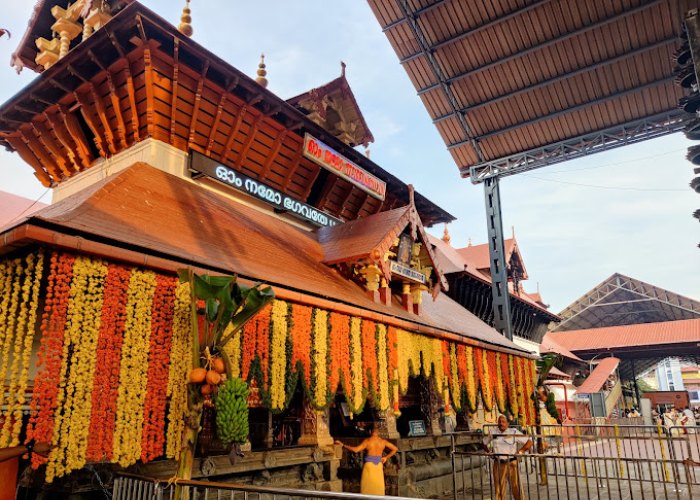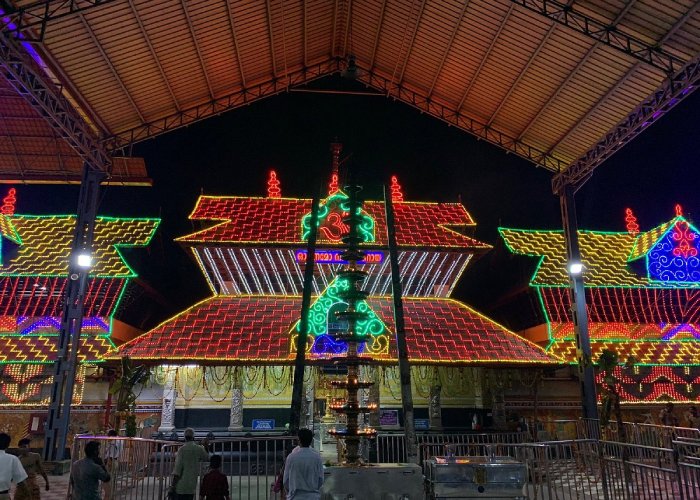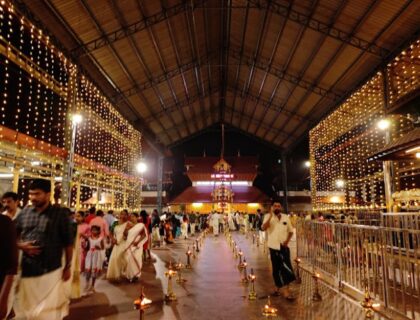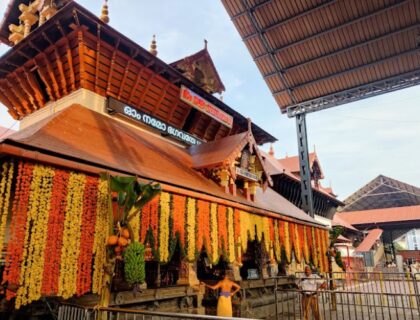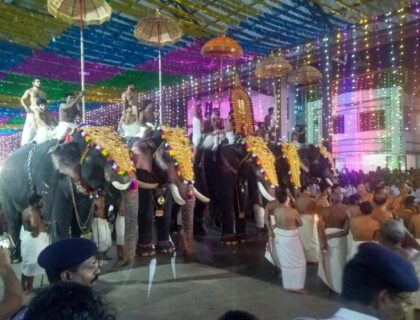Guruvayur Temple
Guruvayur Temple is a Hindu temple dedicated to Guruvayurappan, a four-armed form of the Lord Vishnu, located in the town of Guruvayur in Kerala, India. It is one of the most important Hindu temples in Kerala and Tamil Nadu, and it is also known as Bhuloka Vaikunta (Holy Abode of Vishnu on Earth). The temple is one of the 108 Abhimana Kshethrams of the Vaishnavate tradition.
Guruvayoor, the abode of Lord Sree Guruvayoorappan, is located 29 kilometres northwest of Kerala, the cultural capital of ‘God’s own country.’ Guruvayoor is one of South India’s most sacred and important pilgrimage centres. Guruvayoor is also known as Bhoolokavaikunta, or “heaven on Earth.” Guruvayoorappan is the main deity here, the God who hears the prayers of its pilgrims. Guruvayoorappan is adorned with a holy Tulasi (Basil) garland and pearl necklace, and the Lord appears in full radiance to bless the devotees.
Significance Of the Guruvayur Temple
Guruvayur is home to the historic Sree Krishna Temple, known as the Dwaraka of the South. It is one of the most revered and popular pilgrimage sites in Kerala and throughout the country. The central shrine is thought to have been rebuilt in 1638 CE. The architectural style and individual elements within the shrine are stunning representations of the site’s history.
Story/Legend of the Guruvayur Temple
According to legend, King Janamejaya performed a sacrifice to destroy all snakes in the world, including Takshaka, who was the cause of his father Parikshit’s death. Hundreds of thousands of snakes died in the sacrificial fire, but a Brahmin named Astika stopped the sacrifice before Takshaka was killed.
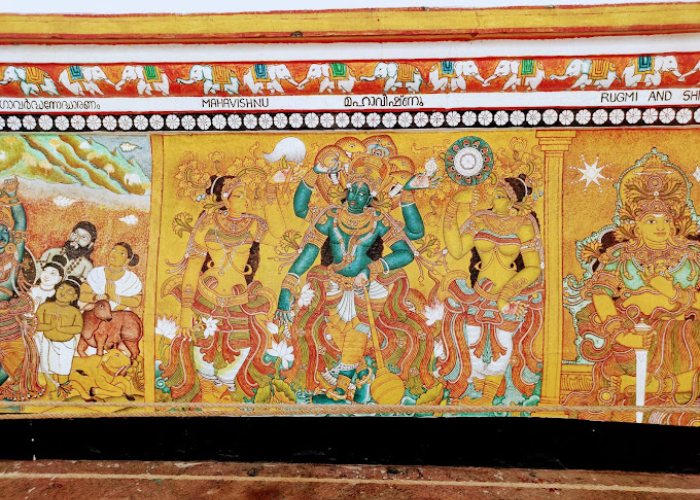
Janamejaya contracted leprosy after causing the deaths of millions of snakes. He gave up all hope of a cure. One day, Sage Atreya (son of Atri) appeared before Janamejaya and advised him to seek refuge under Krishna’s feet at Guruvayur. Atreya informed him that in the Guruvayur temple, Hari’s effulgence is at its peak, and Vishnu bestows his blessings on all devotees. He rushed there and spent the next ten months worshipping the Guruvayur god.
After ten months, he returned home healthy and confronted the astrologer for making a false prediction. The astrologer predicted that he would discover the mark of a snakebite on his left leg. He had only escaped death because he was in a temple where Ananta (the king of serpents) was present, and Ananta was the deity’s brother at Guruvayur, where he had completed his worship.

The king then decided to build a full-fledged temple in Guruvayur. During the Perumal rule in Kerala, this temple was eventually downgraded and reduced to poverty. The Perumal rulers were mostly Shaivites and did not support Vaishnavite shrines. The Shiva temple in Mammiyur received their patronage, and as royal patronage shifted, worshippers followed suit. The Guruvayur temple was thus reduced to absolute poverty.
However, one day, a holy man visited the Mammiyur temple for food and lodging for the night. Despite the temple’s wealth, the authorities pretended they had nothing and scornfully directed him to the neighbouring Guruvayur temple. When the holy man entered the temple grounds, he was greeted politely by a Brahmin boy and generously fed. The holy man was very pleased and bestowed a blessing. According to legend, Mammiyur Siva temple began to decline, while Guruvayur Vishnu temple’s fortunes improved.
History of Guruvayur Temple
The Tamil literature “Kokasandesam” refers to a place named “Kuruvayur” in the 14th century, and there are multiple references to Kuruvayur in the 16th century (fifty years after Narayaniyam was written). The village on the Malabar Coast may be known as Kuruvayur because “kuruvai” means “sea” in Old Tamil.
The earliest temple records date from the seventeenth century. The earliest mentions of Kerala’s many important Vishnu temples can be found in the songs of Alvars, the Tamil poet-saints whose timeline is not entirely clear. However, by the end of the 16th century, Guruvayur had established itself as Kerala’s most popular pilgrimage centre. In 1716, the Dutch raided Guruvayur. They looted treasures and set fire to the Western Gopuram (which was rebuilt in 1747). In 1755, the Dutch destroyed the Trikkunavay temple, and the Brahmins fled.

In 1766, Hyder Ali of Mysore conquered Kozhikkode (Calicut) and then Guruvayur. He demanded 10,000 fanams as a ransom to save the temple. The ransom was paid, but pilgrims withdrew due to security concerns. At the request of Malabar Governor Shrnivasa Rao, Hyder Ali issued a Devadaya to save the temple. In 1789 CE, the Invader Tipu Sultan invaded the province.
Tipu destroyed the smaller shrines and set fire to the Temple, but it was saved thanks to timely rain. Tipu lost to the Travancore and the English in 1792. The idol, which had been hidden underground in preparation for the Tippu takeover, was reinstalled on September 17, 1792.

Ullanad Panikkars rescued and maintained the temple from 1825 to 1900. From 1859 to 1892, the Chuttambalam, Vilakkumatam, Koottambalam, and Sasta shrines were renovated and covered with copper sheeting. In 1900, the administrator Konti Menon established worship hours and spearheaded efforts to keep the temple grounds clean. He installed the large bell and rebuilt Pathayappura (granary). In 1928, Kozhikode was appointed as Guruvayur’s administrator again.
The architecture of Guruvayur Temple
The central icon depicts a four-armed standing Vishnu holding the conch Panchajanya, the discus Sudarshana, the mace Kaumodaki, and a lotus with a Tulasi garland. This image depicts the form of Vishnu as revealed to Krishna’s parents, Vasudeva and Devaki, around the time of his birth. Worship is conducted by Adi Shankara’s routines, which were later formalised in the Tantric way by Chennas Ravinarayanan Nambudiri (1427-1527), whose descendants are the Guruvayur Temple’s hereditary tantris (high priests).

The temple is thought to have been built by Guru, the Gods’ preceptor, and Vayu, the God of the Winds. The eastern nada is the shrine’s main entrance. The gold-plated Dwajasthambam (flag-post) stands 33.5 meters tall in the Chuttambalam (outer enclosure). There is also a 7-meter-high Deepasthambam (pillar of lamps), whose thirteen circular receptacles create a truly stunning spectacle when illuminated.
The square Sreekovil is the temple’s sacred sanctum sanctorum, which houses the main deity. Within the temple, there are also images of Ganapathy, Lord Ayyappa, and Edathedathu Kavil Bhagavathy.

The temple tank (pond) on the northern side of the temple is called Rudratheertham. According to legend, for thousands of years, Lord Shiva used to bathe on the southern bank of this pond. Since Shiva is also known by the name ‘Rudra’, the pond came to be known as Rudratheertham.
Facts about Vishnupad Temple Gaya
- The Guruvayoor Sree Krishna Swamy Temple, also known as the Dwarka of the South, is dedicated to Lord Vishnu and the young form of Lord Krishna.
- The earliest temple records date from the 17th century, but other literary texts and legends suggest that the temple is around 5000 years old.
- According to tradition, every devotee who visits Guruvayoor must also visit Mammiyoor. Only Hindus are permitted inside the temple grounds.
- The central deity is a four-armed standing Vishnu who represents Panchajanya, Sudarshana, Kaumodaki, and a lotus with a Tulasi garland.
- Rituals follow the traditions established by Adi Shankara and formalised by Chennas Ravinarayanan Nambudiri.
- In Vaishnavism, 108 sacred places known as Abhimana Kshethrams are extremely spiritually important. Guruvayur Temple is particularly revered due to its association with Lord Vishnu.
- Punnathur Kotta near the temple houses 56 elephants that were donated by devotees. The world’s largest captive population of male Asian elephants.
- This temple celebrates a variety of art forms. This includes Krishnanttam, a Sanskrit drama. It is unique to this temple and tells the story of Lord Krishna in eight episodes.
- The Guruvayur temple is famous for its temple elephant festival, which attracts large crowds of both foreign and domestic tourists. The elephants are beautifully dressed and paraded for various performances by their mahouts.
- Only Hindus are allowed to enter the temple with a proper dress code to be followed.
Famous Festivals In Guruvayur Temple
- Chitra Poornima is a major occasion for celebration in the temple.
- Krishna Janmashtami – The main festival of this temple is the 10-day festival in the Malayalam month of Kumbham starting with the flag hoisting on Pooyam star.
- Vaikuntha Ekadashi – Vaikuntha Ekadashi celebrated during the Hindu month of Aghan(December–January) is the major festival celebrated in the temple.
- Sri Ram Navami – On this day a special yatra is organised by the temple committee which takes part in the city rath yatra.
- Deepawali is a major Hindu festival celebrated with great joy and enthusiasm.
Best Time to Visit Guruvayur Temple
This place is heavenly and spiritual; you can visit it all year. However, the best time to visit this temple is during the monsoon and winter. During the monsoon season, this location receives moderate to heavy rainfall, making it appear heavenly with its greenery and bringing freshness elsewhere.
How To reach Guruvayur Temple
Location – Guruvayur Sri Krishna Temple, Temple, East Nada, Guruvayur, Kerala 680101
By Air– The nearest airport to Guruvayur Temple is Cochin International Airport, about 87 km from the temple.
By Train– The nearest railway station to the Guruvayur Temple is Guruvayoor railway station which is located at a distance of only 700 meters from the temple
By Road– KSRCT bus Stop which is just 1 km away from the Guruvayur Temple. From here you can easily reach this temple by using local transport services or a taxi or also by any vehicle.
Also, Read – Radhe Krishna Birla Temple Kolkata
Support Us
If our content helps you even 1% in gaining information about the temple, please support us by contributing any amount, our UPI ID is - q417999792@ybl Or pay using QR CODE >>> Click Now
Location
Facilities
- Drinking Water
- Pooja Item Shops
- Prasad Shops
- Restaurants Nearby
- Resting Room





